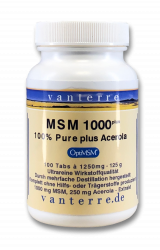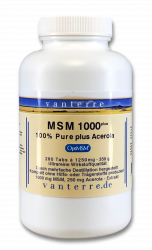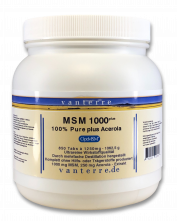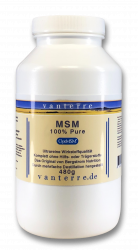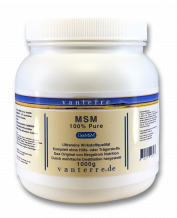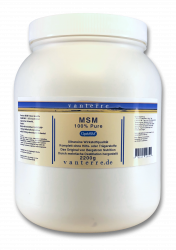Pure OptiMSM™* - Pure Acerola
The best of two worlds - Balchem OptiMSM®* and natural acerola with a very high natural vitamin C content - All without any additives
MSM and sulfur, the neglected nutrient
After calcium and phosphorus, sulfur is the third most common mineral in the human body. MSM is organic sulfur, methylsulfonylmethane, also known as dimethylsulfone. The human body contains about 0.2% of its mass in sulfur, for example, a weight of about 70 kg contains about 140g of sulfur. This is five times more than, for example, magnesium with about 28g, and yet unlike organic sulfur, more magnesium is consumed worldwide. The majority of sulfur in food is supplied by the sulfur-containing amino acids (SAAs) methionine and cysteine. Methionine cannot be produced by our body and must therefore be supplied through diet. Dr. sc. med. Bodo Kuklinski and Dr. Anja Schemionek point out in their book "Mitochondrial Therapy - The Alternative" that "Cysteine and Methionine - In cases of strong oxidative stress, the available amount of glutathione may not be sufficient. Then, other substances (preferably those with sulfur) are attacked, such as α-lipoic acid or coenzyme A. To counteract these effects, sulfur-containing amino acids cysteine and methionine help. They are oxidized instead of the other substances and thereby protect them." Without sulfur, methionine is also lacking. Methionine has many important functions in the body. For example, it transports selenium to various places in the body where it is urgently needed. Without selenium, the immune defense no longer functions properly, and we become more susceptible to inflammation and infections. Selenium is very important for blood vessel walls, connective tissue, and eyes, and it also protects against free radicals. Glutathione, one of the strongest antioxidants, cannot fulfill its function without sulfur to combat free radicals. If the body cannot produce enough glutathione due to sulfur deficiency, increased oxidative stress occurs, weakening the immune system. MSM can counteract this entire oxidative complex. Recent research has shown that OptiMSM™* provides the body with an easily accessible sulfur pool, which prevents essential sulfur-containing amino acids (SAAs) methionine and cysteine from being metabolized due to their sulfur content. Previous pharmacokinetic and metabolic research with orally ingested MSM shows that it is quickly absorbed and well distributed, and then excreted from the body. Its role as a sulfur donor and its ability to maintain SAAs explain the wide range of health benefits observed with OptiMSM™*.
Improved oxygen uptake for cells, detoxification of brain cells
The body requires sulfur to enable amino acids and proteins to enter cells. Without sufficient sulfur, the cell membrane becomes impermeable, making it increasingly difficult to excrete alkaline (acidic) breakdown products, which can cause cells to degenerate or even die over time. Since sulfur quickly forms compounds with other substances, it is excellent for detoxifying heavy metals. The permeability of cells is increased, allowing more nutrients and vitamins to be absorbed, and toxins and pollutants to be transported out of the cell and the body more quickly. MSM also crosses the blood-brain barrier and is thus able to transport toxins from this region as well. It has been shown in experiments to be present in both gray and white matter, with a washout half-life of 7.5 days. Our brain is relatively defenseless against harmful environmental influences. For example, toxins can cause significant damage because pollutants, which tend to concentrate in nerve cells, cause significant neurological damage. Therefore, it is enormously important that MSM, as one of the few antioxidants, crosses the blood-brain barrier and can thus protect against oxidative damage. Of course, it is also advantageous that by improving cell elasticity, toxins can be broken down more quickly.
MSM and Diabetes
Studies have shown that MSM can significantly increase insulin production in diabetics, activate the entire carbohydrate metabolism, and improve the reduced ability to wound healing in diabetes. As a result, patients reduced the amount of insulin they needed to inject. Sulfur is also a component of insulin. When the body is regularly supplied with sufficient MSM, this increases the permeability of the cell membrane, allowing blood sugar to enter the cell more effectively for energy production. Less blood sugar - better metabolism.
Beauty comes from within
A recent study (2020) has shown that oral intake of OptiMSM™ helps reduce the signs of skin aging, such as facial wrinkles and skin roughness, and improves skin firmness, elasticity, and moisture. Since both dosages (1 or 3 grams) were effective, the researchers highlighted the effectiveness of OptiMSM™ in reducing visible signs of skin aging, even at a low dose of 1 gram per day. In a scientific study published at the end of 2019, OptiMSM®* also showed positive effects on hair and nail health, possibly due to its effect on keratin.
What do MSM and DMSO have in common?
When DMSO (Dimethylsulfoxide) is ingested, a part of the DMSO is converted to MSM in the body. MSM is said to have largely the same effects as DMSO, albeit slower than DMSO, but without the typical slightly rancid - garlic-like odor of DMSO, which even emanates through the lungs after several days of DMSO ingestion. MSM is attributed with significantly anti-inflammatory, antioxidant, immunomodulatory, and antitumor properties. MSM acts against pain similarly to DMSO, and MSM has many of the same effects as DMSO. In a study from the 1990s, researchers found that the transmission of pain impulses was already slowed down by low concentrations of DMSO. DMSO inhibits pain impulses in the C fibers, the nerve fibers that transmit pain impulses. C fibers transport pain impulses from damaged tissue to the brain. Other studies have shown that DMSO can even cause a blockade of the central pain response in the brain, where the pain is received. Exactly the same effect is suspected for MSM as well.
In the late 1970s, Robert Herschler researched the natural metabolites of DMSO at the Oregon Health Sciences University in Portland under the direction of Professor Stanley Jacob. It was already known from earlier studies that MSM is the main metabolite of DMSO. After the body absorbed DMSO, about 15% was converted to MSM. Urine analysis showed that orally ingested DMSO was no longer detectable in the urine after 120 hours, but MSM could still be detected after 480 hours. The delayed excretion is probably due to the fact that MSM binds more strongly to body tissue than DMSO. The researchers also found that many of the medical effects attributed to DMSO are likely due to its metabolite MSM. And it turned out that MSM is much more user-friendly than DMSO: it is more stable, odorless, and does not cause skin irritation. The user does not emit that strong characteristic smell.
MSM - Qualities - natural? - synthetic? - pure? - highly bioavailable?
There are strange rumors circulating about MSM on the internet. There was talk of production from pine wood until an investigation of carbon dating by the laboratories of Beta Analytic revealed that the characteristic amount of radioactive carbon 14, which is found in every product made from recently living material (tree, pine wood, corn, biomass), was not found (zero) in any product. However, it was clear: it cannot come from plant production.
Everywhere you find MSM offers with "absolute" purities of about 99.6 to 99.9 percent. That sounds almost like 100% pure! Great! And what does that mean when you take a closer look? Calculated per kilogram, it means 996 to 999 grams out of 1000 grams are pure, meaning we have one to four grams left over. However, what these four grams consist of became quickly and clearly apparent. They contain exactly the impurities, heavy metals from the wastewater (so-called strong black liquor) of the paper industry. This is the cheapest source for producing MSM or DMSO. The naturally occurring lignin in wood is separated during paper production from the cellulose needed by the paper industry. The methyl groups are isolated and converted into dimethyl sulfide (DMS) by adding sulfur. This is then converted into DMSO by catalytic oxidation with oxygen. From this, MSM and water are produced again by adding hydrogen peroxide in an oxidation process. However, the productions then take two completely different paths. All MSM products except OptiMSM®* from Bergstrom are "cleaned" by heating (and evaporating). However, the contaminants and heavy metals contained therein cannot be removed because they do not simply dissolve into the air even after multiple boiling and refilling with water. This process is found everywhere under the designation of crystallization, sometimes also 3-fold or 4-fold crystallization, but this does not change the fact that this (naturally cost-saving) process cannot really remove everything conclusively.
The patented and worldwide unique process by Balchem to separate impurities is as follows: Firstly, no black liquor is used as the starting material, but Bergstrom obtains its DMS directly in the quality demanded by Bergstrom from the pharmaceutical industry. However, the most important thing is the cleaning of the end product through multiple distillation, not evaporation by heating, so that no residues remain in the MSM. This is the only way to obtain completely pure material, and Bergstrom operates the only plant worldwide where only MSM and nothing else is produced. This also eliminates contamination from the production of other substances, and it is no coincidence that OptiMSM®* is the only MSM worldwide to have obtained approval from the US FDA as a pharmaceutical and medical product.
OptiMSM®* is a trademark of Balchem Corporation, which is manufactured in the USA in a single-purpose production facility and cleaned by a protected multi-stage distillation process. In this process, impurities are removed by using specified boiling points to isolate the MSM molecules. Distillation also guarantees a low moisture content, which is reflected not only in weight but also prevents micro-contaminants and loss of quality. This results in MSM with a calculated purity of 99.9999974%, as far as today's laboratory analysis technology goes.
In nature and in the human body, MSM is formed by the sulfur cycle of the earth, but the natural sources are far too low for MSM production. Therefore, all commercially available MSM is produced using processes that mimic the sulfur cycle of the earth and, when used correctly, yield the same results as nature. MSM's ability to reduce inflammation and oxidative stress makes it an important component for overall health. Chronic inflammation is associated with a range of health problems and the aging process. Research on MSM continues to support its inclusion in various formulations, ranging from joint health to beauty, cognitive and immune health, and sports nutrition.
OptiMSM® uses the much more complex and costly distillation process to clean MSM. The MSM is heated to the boiling point of 238°C. The resulting "MSM vapor" is cooled down, and crystallizes back into MSM crystals. This process is repeated several times, resulting in MSM crystals of the highest possible purity:
1. All impurities with lower boiling points evaporate before the MSM. These impurities are mainly organic compounds.
2. But most importantly, all impurities with higher boiling points remain in the so-called distillation column. These impurities are mainly heavy metals. They have much higher boiling points:
Mercury (Hg): 356°C
Lead (Pb): 1740°C
Cadmium (Cd): 765°C
Arsenic (As): 613°C
OptiMSM®* from Balchem is, according to today's laboratory technology, the only MSM without detectable heavy metals worldwide. You wouldn't really want heavy metals in a mineral meant for cell detoxification and crossing the blood-brain barrier. After extensive research, we chose OptiMSM® simply because Balchem is the only manufacturer worldwide that purifies MSM through distillation multiple times, and that too in a production facility exclusively reserved for MSM production. The entire site is a product. Below are the results, which are also roughly the limits of detection according to today's laboratory technology.
Mercury (Hg): < 0.001 ppm (mg/kg)
Cadmium (Cd): < 0.005 ppm (mg/kg)
Arsenic (As): < 0.01 ppm (mg/kg)
Lead (Pb): < 0.01 ppm (mg/kg)
Here is another quote from Dr Stanley W. Jacobs, the late professor of surgery at Oregon Health Sciences University in Portland, Oregon, USA:
"MSM is an abbreviation for methylsulfonylmethane, an organic form of naturally occurring sulphur. It is also known as dimethylsulphone. This is the form in which sulphur occurs naturally in all living organisms and is biologically active. MSM is found primarily in fresh fruits and vegetables. It is also found in the human body. MSM is part of the natural sulphur cycle and plays a crucial role in many important functions of the human body that contribute to maintaining good health. MSM has been studied for over twenty years at Oregon Health Sciences University Hospital in Portland, Oregon. In my medical clinic at the university hospital, I have personally used MSM on thousands of patients in my practice. A few years ago, I published my experiences with MSM in my book ‘The Miracle of MSM: The Natural Solution to Pain.’ This book was published in the United States in 1999. I recently wrote a comprehensive overview of the science and therapy of MSM (‘MSM, The Definitive Guide,’ 2002). I believe it is important to discuss an important issue that affects not only MSM but many of the dietary supplements now available worldwide. This issue is purity and potency. As MSM has become more popular, many similar products have appeared on the market. Beware of material that is adulterated, contaminated or of lower potency than is necessary for effectiveness. Some brands appear to have been contaminated with heavy metals, fungi or microbes. Other brands have been diluted with Epsom salt, sometimes by up to 50%. This concerns me greatly, as contaminants can not only be harmful to health, but the effectiveness of MSM also depends entirely on the quality of the materials from which it is made. For this reason, I always recommend a product called ‘OptiMSM™*’. OptiMSM™* is the trade name for MSM manufactured in the United States by Balchem Nutrition, the dedicated MSM manufacturer based in Vancouver, Washington. I have evaluated various brands and consider OptiMSM™* to be the highest quality available. It is the only one I will use or recommend for my patients. Bergstrom Nutrition (formerly Cardinal Nutrition) was the first commercial supplier of food-grade MSM over a decade ago and remains the world's leading supplier of premium-quality MSM. I continue to work with Bergstrom and help direct their research efforts."
There was a very interesting interview by Trung Nguyen with Patrick McGean, director of the Live Blood and Cellular Matrix Study - Body Human Project, which has been translated into German. Unfortunately, the site itself is no longer active, so I had to remove the link. It's about sulphur, the history of sulphur and the attempt to explain sulphur deficiency, as well as findings on which sulphur is effective. It also discusses a theory as to why the sulphur cycle in humans may be interrupted and where the causes might lie.
Here are a few excerpts:
"In 1999, Mr Patrick McGean's son was diagnosed with germ cell testicular cancer. He underwent several operations, cisplatin chemotherapy and finally an autologous stem cell transplant. After the transplant, his oncologists explained that the treatment had been unsuccessful and that he had a 3% chance of survival for the next few years. The Living Blood study was started with this information, and the introduction of sulphur was a coincidence. With intimate knowledge of blood and the cardiovascular system from the 1970s, it made sense to find a way to photographically monitor the blood in the hope of being able to visualise changes that could be used to monitor the health of the participants. The blood vessels of the conjunctiva and the blood cells they contain became the model, and various types of microscopes were used to view the vessels and blood. After extensive online research on sulphur and the cardiovascular system, we realised that the cell matrix visible on the face could be a more valuable way to establish cell regeneration in individuals who are too far away to be exposed to a microscope placed in their eyes. Research into sulphur revealed a relationship between oxygen and cancer, aerobic versus anaerobic cell metabolism, as described by Otto Warburg. He received a Nobel Prize in 1930 for proving that cancer is anaerobic. An online study from the United Kingdom described 28,000 women who opted against further surgery, chemotherapy or radiotherapy for their breast cancer, choosing instead a pure form of MSM, and had no recurrence of their cancer between 1975 and 2000. This article prompted me to encourage my son to take sulphur. He is alive and cancer-free 8 years later. Our study was initiated not only to explain that we have a sulphur deficiency, but also that most of the MSM methylsulfonylmethane we tested was not as effective as early researchers such as Dr Stanley Jacob had shown. The examples of cell regeneration were only reported when we found a pure crystal precipitate that had not been processed after precipitation. When the same crystal was pulverised, our study participants reported that it was less effective. MSM in pill, capsule or powder form is manufactured with anti-caking agents (flow agents), and as described in connection with the easy binding of sulphur, these flow agents have been reported to inhibit or block the absorption of sulphur."
‘What is the fertiliser in our food made of and what effects does it have on our health? How does today's fertiliser differ from pre-industrial fertiliser in terms of mineral content?’
"Pre-industrial fertilisers were organic, natural decomposition of organic material, mainly manure. Chemical fertilisers are produced by high-temperature processing of inorganic materials [synthetic] such as coal tar and later crude oil. The problem seems to be the use of temperatures above the evaporation point of sulphur, as described on the petrochemical company's own websites.
Those cultures that have organically fertilised food supplies have fewer diseases than those that use artificial forms of plant nutrition. Finland banned the use of chemical fertilisers in 1985 because it feared cadmium and its perceived toxic properties. Their epidemiology has shown a 10-fold improvement compared to that of the United States in 1985, which had almost identical figures.
This is a story too complicated to tell briefly. But in terms of sulphur, this will hopefully suffice. Chemical fertilisers were first developed in the 1700s by a Polish researcher. It was not until I.G. Farben (Bayer) took up this research and began producing chemical fertilisers from coal tar in 1860 that their use began to affect the people who ate the food. Two medical events that occurred in Germany could, in our opinion, be directly related to these fertilisers. As early as 1906, Dr Alzheimer described ‘women who have lost themselves in their own minds’, although Alzheimer's had not been observed in countries other than Germany until after the introduction of these chemical fertilisers. Most European countries had already introduced these fertilisers before the start of the Second World War. In 1920, Dr Otto Warburg had the opportunity to research cancer sufficiently to describe the basis for his Nobel Prize-winning work, while cancer was less evident in other countries. In 1938, when gas and crude oil were cheap, Prescott Bush [the grandfather of then (2008) US President George W. Bush] and Nelson Rockefeller [the son of John D. Rockefeller] signed a contract with I.G. Farben to develop a crude oil-based fertiliser in the West Nile region of Africa. This formula, known as ammonium sulphate and ammonium nitrate, is the leading formula for most chemical fertilisers used worldwide.
These fertilisers are sulphur-free due to the temperatures of 193°C at which they are “cracked”. Secondly, these fertilisers bind free sulphur from the sulphur cycle present in rainwater.
Sulphur is the forgotten nutrient, as Dr. Beth Ley, Ph.D., notes, sulphur is the third or fourth most important mineral (element) necessary for a healthy metabolism, yet sulphur is not discussed in medical or scientific literature. It is assumed that we obtain all the sulphur we need from our food, and that may have been the case until we changed the way we grow our food.
A review of epidemiology in the United States since 1954, when chemical fertilisers became mandatory, shows an increase in cancer and other diseases of up to 4,000%. The responses of our study participants seem to indicate that these disease entities were reversed or positively addressed by adding sulphur to their diet.
Finland is an interesting case study for the effects of chemical fertilisers. Fearing the cadmium contained in these fertilisers, Finland banned their use in 1985. Nowhere was sulphur ever mentioned in relation to these fertilisers.
Other cultures, such as the Amish, who use only organic fertilisers, also enjoy fewer diseases, although we must rely on the few studies available on their ‘epidemiology.’ Okinawa and South Korea have lower disease rates compared to the rest of Japan or North Korea. Brazil has higher disease rates than Argentina, which relies on manure rather than chemical fertilisers.
Chemical fertiliser manufacturers argue that their products yield higher crop yields, but the question is whether the nutritional value is also higher compared to the gross tonnage. [A very interesting point]
You wrote: ‘Research on sulphur has revealed a relationship between oxygen and cancer, aerobic versus anaerobic cell metabolism, as described by Dr Otto Warburg. He received a Nobel Prize in 1930 for proving that cancer is anaerobic.’
That's very fascinating. Linus Pauling was the only person in history to be awarded two undivided Nobel Prizes, and he stated: ‘Every disease and every ailment can be traced back to a mineral deficiency.’ Everett Storey, another scientist who invented the water-splitting technology that made the hydrogen bomb possible, stated: ‘It is time for the concept to be generally accepted that our bodies, even in some terminal cases, can be supplied with essential building blocks [oxygen, electrolytes, minerals, enzymes, amino acids] to repair and restore every living cell within 11 months.’ Now Dr Otto Warburg, another Nobel Prize winner, comes into play.
‘Can you briefly describe the “relationship between oxygen and cancer, aerobic vs. anaerobic cell metabolism” and the work of Dr Otto Warburg?’
"Cell biology can be rephrased as cell regeneration. Throughout our lifetime, we regenerate all our cells except memory cells. What Dr Otto Warburg described was anaerobic cell metabolism in plants as a healthy model. When plants were forced into aerobic metabolism, fermentation occurred and cell regeneration ceased, resulting in plant cell necrosis. On the other side of the symbiotic scale, when animal cell metabolism becomes anaerobic, a similar form of fermentation or acidosis becomes the norm. An animal cell undergoes mitosis (cell division) with or without intracellular oxygen, or it dies if such mitosis does not occur.
What Dr. Warburg described was anaerobic cellular metabolism in carbon dioxide or waste gas that remains in the cell when no oxygen is transported into the cell; gas transport is cellular respiration, no new oxygen enters to push out the carbon dioxide.
Dr. Warburg ‘proved’ that such anaerobic metabolism was the precursor to cancer. He explained that all cancer can be linked to such anaerobic metabolism, which allows cells to become acidic, and that the energy produced by the cells is a function of fermentation and not of oxygen-activated ATP.
Dr. Warburg's research leads us to believe that viral infections are also anaerobic, and we have received a remarkable response from the few study participants who suffer from Hep C and HIV. Reducing the viral load may not be as important as regenerating the liver of Hep C-infected individuals. Or liver transplants, if the infected individuals can get on a transplant list. Both procedures lead to cell degeneration, not only in the liver but also in other cellular systems. We have too few study participants suffering from these viral diseases to make any claims, but we are confident that sulphur could help without harmful side effects. We encourage anyone who is infected to consider participating in our study, along with any other modalities they are currently relying on. Oxygen is the enemy of all viruses, whether through its presence in the cell or through the flexibility of the cell membrane, which makes the virus unable to ‘enter’ the cell.
For me, the most fascinating thing about the whole interview is the conclusions. Germany was the first country to use artificial fertilisers in agriculture and at the same time the first country in which Alzheimer's was observed. The other countries followed successively with fertilisation, but also with Alzheimer's, cancer and other diseases. This raises the question of how an aerobic metabolism deals with anaerobic fertilisers. Not only in food, in the environment, breathing air, groundwater etc.....
Our MSM flakes are the pure crystal precipitate, unground and untreated, simply pure. Our tablets are made without any flow aids or other additives, they also do not contain any substances that do not need to be specified, the 250mg of added acerola comes from Brazil and is sustainably grown and selectively harvested in a small operation without chemical fertilizers or pesticides, to ensure the extremely high vitamin C concentration of 27-30%. The acerola powder is freeze-dried and also contains no binders, not even unspecified ones (they don't even need to be listed on the packaging) like maltodextrin or acacia gum, of course also no additional ascorbic acid for "standardization". But all acerola polyphenols and bioflavonoids are included for improved bioavailability and metabolism as well as duration in the body.
Therefore, the vitamin C values fluctuate depending on the vintage and harvest between 25% and sometimes a little over 30%.
Simply the pure active ingredients pressed into a tablet with 1000mg of MSM and 250mg of pure acerola.
OptiMSM®* is a trademark of Balchem Corporation or its subsidiaries
Powered by Froala Editor
v a n t e r r e 280 X OptiMSM® 1000plus Acerola
EUR 51,50
EUR 147,14 pro Kilogramm
incl. 19 % VAT excl. shipping costs
v a n t e r r e 480g Pure OptiMSM®
EUR 25,50
EUR 53,13 pro Kilogramm
incl. 19 % VAT excl. shipping costs

